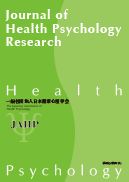Volume 34, Issue 1
Displaying 1-3 of 3 articles from this issue
- |<
- <
- 1
- >
- >|
Original article
-
2021 Volume 34 Issue 1 Pages 1-12
Published: September 28, 2021
Released on J-STAGE: September 24, 2021
Download PDF (596K)
Brief report
-
2021 Volume 34 Issue 1 Pages 13-22
Published: September 28, 2021
Released on J-STAGE: September 24, 2021
Advance online publication: May 20, 2021Download PDF (319K)
-
2021 Volume 34 Issue 1 Pages 23-28
Published: September 28, 2021
Released on J-STAGE: September 24, 2021
Advance online publication: July 15, 2021Download PDF (688K)
- |<
- <
- 1
- >
- >|
